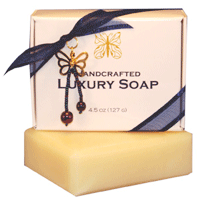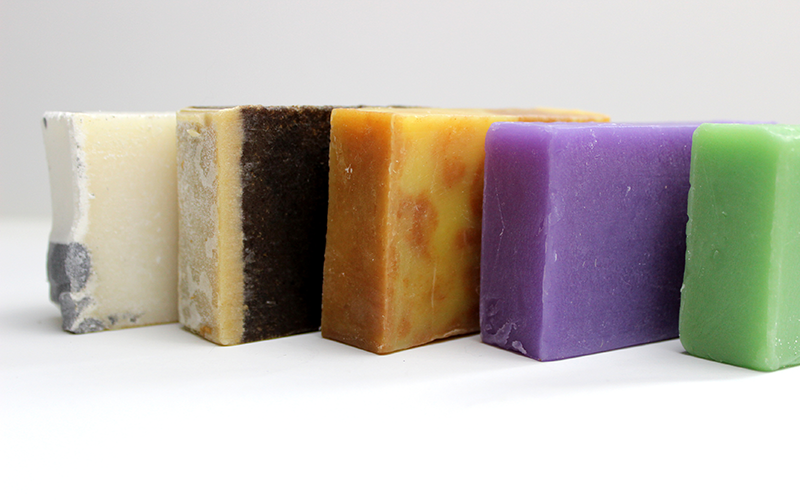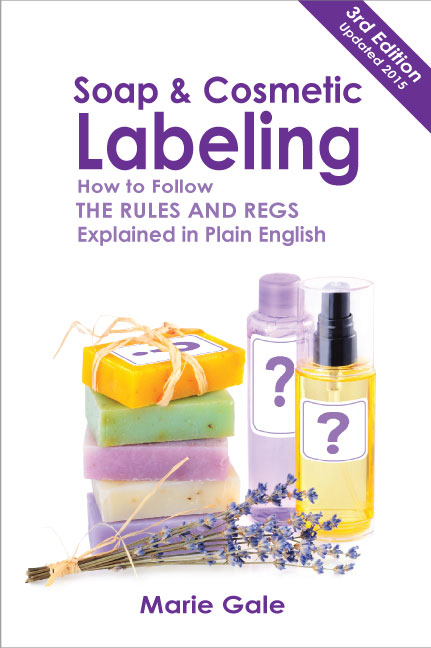Soap has some interesting labeling issues when it comes to the ingredient declaration. It is a chameleon—it can be a consumer commodity, or a cosmetic, or an insecticide, or a drug.
Whether or not the ingredient declaration is required on a soap depends on what it is in the eyes of the law, what the ingredients are, and what claims are made about it.
What is it?
Soap can be many things, depending on how it is made and what claims are made about it.
Is It “True Soap”?
The first thing to determine is whether it is “true soap” as defined by the FDA. A true soap is one in which “the bulk of the non-volatile portion consists primarily of an alkali salt of fatty acids” (according to the FDA regulations). In other words, it is made with lye and oils.
A true soap is exempt from FDA cosmetic regulations, and its labeling requirements are governed by the Fair Packaging and Labeling Act. The name of the product, the net weight and the name and address of the manufacturer, distributor or packager are required on the label; the ingredient declaration is not required for a true soap.
In order to be exempt from other labeling requirements, the only claims that can be made about a true soap are that it is soap and that it cleanses. A true soap becomes a different type of product if other claims are made about it.
A soap that is made primarily with detergents or other ingredients, is NOT a true soap. Most, but not all, melt and pour soaps, are not “true soap.” A soap that is not a true soap is usually a cosmetic.

Is it a Cosmetic?
As noted above, a soap that isn’t a true soap is automatically considered a cosmetic if it’s used on the human body. However, a true soap can be a cosmetic if a cosmetic CLAIM is made about the soap or one of its ingredients. If you say “contains moisturizing shea butter,” it has become a cosmetic. If you say it’s a “moisturizing soap,” it is now a cosmetic.
Cosmetic labeling is governed by the FDA. The label requires the name of the product, what it is, the net weight, the name and address of the manufacturer AND a declaration of the ingredients.
Is It Something Else?
A soap that claims to “repel insects” becomes an insecticide and is governed by the EPA’s labeling requirements.
A soap that claims to “cure, treat, mitigate or prevent disease” or that is intended to “affect the structure or any function of the body” is a drug, and is subject to the FDA drug approval and labeling regulations. Some common drug claims for soap include: “anti-bacterial,” “kills fungi,” “treats or cures eczema,” etc. Note that if a claim is made for an ingredient in the soap it is still considered a claim for the soap itself, so claiming that a soap contains tea tree oil which is “known to be antibacterial” can make the soap a drug.
Cosmetic Ingredient Declaration
If the soap is a cosmetic, then the cosmetic ingredient declaration is always required. The ingredient declaration must be in descending order of predominance, except that ingredients at less that 1% can be listed in any order after the ingredients at more than 1%. There are some other exceptions for FDA-approved colorants and multi-product packages.
The ingredients need to use the INCI name or the common name if no INCI name is assigned. For botanicals, the common name is required; the latin name may be included. It’s important to note that the “saponified oil of ____” is NOT a valid ingredient name.
What About Lye?
An ingredient declaration can state what goes into the soap pot or what comes out of the soap pot. Since making soap has a resultant chemical reaction, that gives you two different ways to present the ingredients.
What Goes Into The Soap Pot
In a typical example soap, what goes into the pot is oil, lye, water and additives. Therefore a valid ingredient declaration would be “Water, palm oil, coconut oil, olive oil, sodium hydroxide, lavender essential oil, and mica.”
The oils could also include the Latin name of the plant.
What Comes Out Of The Soap Pot
Using the correct INCI names, what comes out of the soap pot is mostly sodium palmate, sodium coocate, sodium olivate, lavender essential oil and mica. HOWEVER, there are also water, glycerin and any unsaponified oils.
The problem with declaring the ingredients based on what comes OUT of the pot is that you don’t (normally) know exactly how much water, glycerin, and unsaponified palm oil, coconut oil, and olive oils are still in the soap—so you can’t put them in the right order.
It is possible to calculate the amounts, though.
Ingredient List When It’s Not Required
Sometimes (quite often, actually) a soapmaker has a true soap for which no cosmetic claims have been made, but still wants to tell their customers what is in the soap. Since it’s not a cosmetic, the FDA regulations don’t apply, so there is considerably more freedom in what you can say.
In this case, you could use “saponified oils of ___.” The ingredients don’t necessarily have to be in descending order of predominance. They don’t even have to all be included.
A Note of Advice
If you do decide to put the ingredients on a true soap, be aware that consumers expect that if you say “Ingredients: ____”, you are stating all of the ingredients in descending order of predominance. While withholding ingredients isn’t in violation of the FDA regulations, it might be considered “deceptive.”
A better way to do it, if you are using non-standard ingredient names (such as “saponified oils of ___,” or you are not putting all the ingredients on the list (for example, saying “essential oil blend” instead of listing them all out), it’s probably better to put it as marketing information, rather than an actual “ingredient declaration.”
Something like “We make our soaps with saponified oils of ___ and scent them with only pure essential oils, including much-loved lavender and patchouli oils.” That makes it more informative, and the consumer can see that it’s not a true ingredient declaration such as they would normally expect on cosmetics.


Leave a Reply